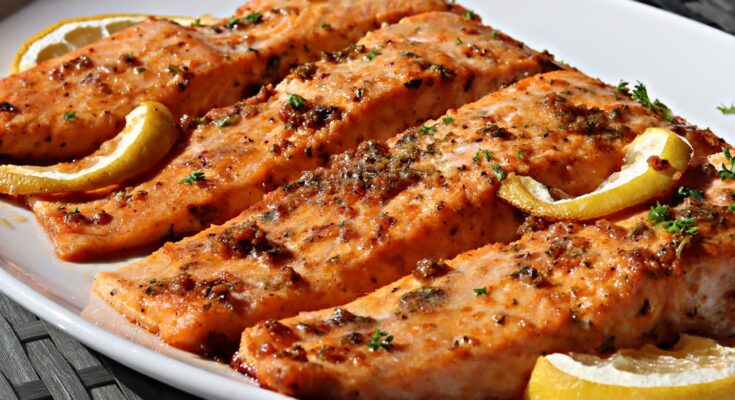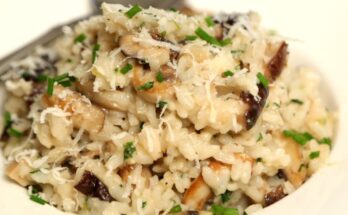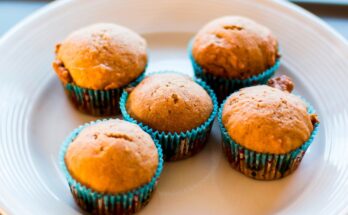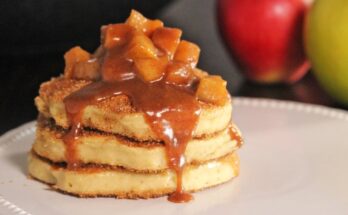Pan Seared Salmon Recipe: Pan seared salmon is one of those meals that looks fancy, tastes gourmet, but is surprisingly simple to whip up in your own kitchen. It’s the kind of dish that turns a regular dinner into something special, without requiring a long grocery list or hours in the kitchen. With just a hot pan, a piece of fresh salmon, and a few pantry staples, you can create a restaurant-quality meal at home.
Why is pan seared salmon so beloved? First off, it’s incredibly versatile. You can serve it with a light salad, creamy mashed potatoes, or a medley of roasted vegetables. It’s perfect for busy weeknights but classy enough for date night or hosting friends. Secondly, it’s packed with nutrients—salmon is a powerhouse of protein, omega-3 fatty acids, B vitamins, and antioxidants.
This dish also delivers on flavor and texture. The magic happens when that salmon hits a hot pan—creating a golden, crispy crust on the outside while keeping the inside flaky, moist, and tender. And let’s be honest—who doesn’t love a satisfying sizzle in the kitchen?
Whether you’re new to cooking or a seasoned home chef, this step-by-step guide will walk you through making the perfect pan seared salmon every single time.
Ingredients Needed
Before we get cooking, let’s go over the ingredients. You don’t need anything too exotic—just a few simple items will do the trick.
Main Ingredients
- 2 salmon fillets (preferably 6 oz each, skin-on)
- 1 tablespoon olive oil or avocado oil
- Salt (to taste)
- Freshly ground black pepper (to taste)
- 1 tablespoon unsalted butter
- 2 cloves garlic, minced
- 1 teaspoon lemon juice
- Optional: fresh herbs like thyme or parsley for garnish
Optional Add-ins for Extra Flavor
- A sprinkle of paprika or smoked paprika
- Lemon zest for a citrusy brightness
- Crushed red pepper for a kick
- A splash of white wine to deglaze the pan
- A spoon of honey or mustard for a glaze twist
Having these items prepped and ready will streamline the cooking process and ensure everything comes together smoothly. Don’t stress if you’re missing an optional ingredient—this recipe is flexible and forgiving.
Choosing the Right Salmon
Before diving into the pan, it’s important to choose the right cut of salmon. The quality of your fish will make or break the dish.
Fresh vs Frozen Salmon
Fresh salmon is usually the top pick, but high-quality frozen salmon can be just as good if handled properly. If you go frozen, make sure to thaw it completely in the fridge overnight or under cool running water. Pat it dry thoroughly before cooking—extra moisture is the enemy of crispy skin.
Skin-On vs Skinless Fillets
Skin-on salmon is ideal for pan searing. The skin protects the delicate flesh from overcooking and helps achieve that irresistible crunch. Plus, if cooked right, the skin itself is a savory treat. However, if you only have skinless salmon, it’s still doable—just be extra gentle when flipping to avoid breaking the fillet.
Preparing the Salmon
The preparation stage is often overlooked, but it’s key to a flawless finish.
How to Properly Clean and Dry Salmon
First, rinse your salmon fillets under cold water to remove any scales or residue. Then, pat them very dry with paper towels. Removing surface moisture is crucial—moisture causes the salmon to steam instead of sear, ruining your crust.
Inspect the salmon for pin bones. Run your fingers along the flesh and use tweezers to pull out any that remain. Nobody wants a surprise bone mid-bite!
Seasoning Basics
Season simply but generously. Sprinkle both sides with salt and pepper. You can add garlic powder, onion powder, or paprika if you’re feeling fancy. But remember: the goal is to enhance, not overpower, the natural flavor of the fish.
Step-by-Step Cooking Instructions
Ready to cook? Here’s how to pan sear salmon like a pro.
Tools and Equipment Needed
- A heavy-bottomed skillet (cast iron or stainless steel works best)
- Fish spatula (thin and flexible)
- Tongs (optional)
- Paper towels
- Stove
Searing the Salmon to Perfection
- Heat your pan: Place your skillet over medium-high heat and let it get hot—really hot. This takes about 2–3 minutes. You’ll know it’s ready when a drop of water sizzles and evaporates instantly.
- Add oil: Swirl in 1 tablespoon of oil and let it shimmer. You want the oil hot but not smoking.
- Place the salmon skin-side down: Carefully lay the fillets in the pan, skin side down, away from you to avoid splatter.
- Press gently: For the first 30 seconds, press down gently on each fillet with a spatula to prevent curling.
- Let it sear undisturbed: This is where the magic happens. Let the salmon cook without moving it for 5–7 minutes. The skin will become crisp and release from the pan when it’s ready to flip.
- Flip and finish: Turn the fillets over and cook for another 2–4 minutes, depending on thickness.
- Add butter and aromatics: In the last minute, add butter, garlic, and a squeeze of lemon. Baste the salmon with the melted mixture for added flavor.
- Remove and rest: Take the salmon off the heat and let it rest for a couple of minutes before serving.
Tips for Crispy Skin and Juicy Interior
Achieving that golden, crackling skin while keeping the salmon juicy on the inside isn’t magic—it’s a technique. Let’s break it down.
1. Patience is key. Don’t rush the searing process. Many people flip the salmon too soon, which prevents the skin from crisping and can cause it to stick. Let the heat do its job. When it’s ready, the skin will release easily from the pan.
2. Dry the skin thoroughly. Before placing the salmon in the pan, ensure the skin is completely dry. Moisture on the surface leads to steaming rather than searing. A paper towel is your best friend here.
3. Use high-smoke point oils. Oils like avocado oil, grapeseed oil, or canola oil are best for searing because they can handle high temperatures without burning. Olive oil can work but tends to smoke quickly.
4. Let it rest. After cooking, give your salmon a couple of minutes to rest. This helps the juices redistribute, keeping the inside moist and tender.
5. Press gently when searing. During the first 30 seconds in the pan, use a spatula to press the salmon down lightly. This keeps the skin in full contact with the hot surface, preventing curling and ensuring even crispiness.
Mastering these small but essential steps can turn a good salmon dish into a great one.
Serving Suggestions
You’ve nailed the salmon—now what should you serve with it?
Side Dishes That Pair Well
- Garlic mashed potatoes – Creamy and buttery, they’re a great match for the rich flavor of salmon.
- Steamed or roasted vegetables – Asparagus, broccoli, and Brussels sprouts are perfect choices.
- Rice pilaf or quinoa – A wholesome, nutty base that complements the fish without overpowering it.
- Fresh salad – Think arugula with cherry tomatoes and a lemon vinaigrette for something light and zesty.
Sauce Options for Extra Zing
- Lemon butter sauce – Classic and foolproof.
- Garlic herb yogurt sauce – Cool and refreshing.
- Dill cream sauce – Pairs beautifully with the natural oils of the salmon.
- Honey mustard glaze – Sweet and tangy, great if you like a little punch.
Serving salmon is all about balance. You want sides and sauces that complement, not compete with, the main attraction.
Common Mistakes to Avoid
Even seasoned cooks can trip up when making pan seared salmon. Let’s look at what not to do.
1. Overcooking the salmon. This is probably the biggest mistake. Salmon cooks quickly—just 7 to 10 minutes total depending on thickness. Overcooking makes it dry and tough. Use a thermometer if you need to: 125°F (51°C) for medium-rare, 130°F (54°C) for medium.
2. Not letting the salmon come to room temperature. Cold salmon straight from the fridge doesn’t cook evenly. Let it sit at room temp for 15–20 minutes before cooking.
3. Skipping the drying step. Wet salmon won’t sear well. Moisture causes sticking and prevents that crispy skin you’re aiming for.
4. Flipping too soon. Resist the urge to poke and prod. The salmon will naturally release from the pan when it’s ready to be flipped. If it sticks, give it more time.
5. Using the wrong pan. A nonstick pan might seem like the easy choice, but a cast iron or stainless steel skillet gives a better sear.
Avoiding these common slip-ups will make your cooking experience smoother—and your salmon more delicious.
Storage and Reheating Tips
Got leftovers? No problem! Salmon keeps well if stored properly and reheated with care.
- Storage: Let the salmon cool completely, then store in an airtight container in the fridge. It will stay fresh for up to 3 days.
- Freezing: Wrap the salmon tightly in plastic wrap and then foil, or use a freezer-safe bag. Store for up to 2 months. Thaw in the refrigerator overnight before reheating.
- Reheating: Use low, gentle heat to avoid drying out the fish. The best way is to reheat it in a covered skillet over low heat with a splash of water or broth. Alternatively, use the oven at 275°F (135°C) for about 10–15 minutes.
Salmon is one of the few proteins that tastes great even the next day—especially when it’s been cooked with love and care.
FAQs about Pan Seared Salmon Recipe
1. What’s the best type of salmon to use for pan searing?
Wild-caught salmon like sockeye or king salmon is ideal for pan searing due to its firm texture and rich flavor. But farm-raised Atlantic salmon works great too if that’s what you have.
2. Should I leave the skin on or take it off?
Leave the skin on! It gets crispy and acts like a natural barrier, keeping the salmon moist and flavorful while cooking.
3. How long should I sear salmon in the pan?
About 4-5 minutes on the skin side and 2-3 minutes on the other side, depending on thickness. Aim for a golden crust and opaque pink center.
4. What kind of pan should I use?
A heavy-bottomed stainless steel or cast-iron skillet is perfect. Non-stick pans can work, but they won’t give you that crispy sear magic.
5. Should I marinate the salmon before cooking?
Not necessary. A simple seasoning of salt, pepper, lemon juice, and maybe garlic or herbs is enough. But if you want extra flavor, a short marinade (15–30 mins) can be used.
6. What oil is best for pan searing salmon?
Use oils with a high smoke point like avocado oil, grapeseed oil, or canola oil. Olive oil works too, but keep the heat moderate to avoid burning.
7. How do I know when my salmon is fully cooked?
It should flake easily with a fork and have an internal temperature of 125°F (52°C) for medium. If you’re a texture person, go slightly under—it keeps the fish buttery and juicy.
8. Can I use frozen salmon?
Yes, but thaw it completely and pat it dry with paper towels to remove excess moisture before searing.
9. What sides go well with pan seared salmon?
Think light and fresh—steamed veggies, mashed potatoes, garlic rice, quinoa, or a lemony salad. You can’t go wrong.
10. Can I make pan seared salmon ahead of time?
It’s best fresh, but you can prep it ahead and reheat gently in a skillet. Just don’t microwave it unless you’re okay with the fish turning sad and rubbery.
Conclusion
Pan seared salmon is proof that delicious doesn’t have to mean difficult. With just a few quality ingredients and a little kitchen know-how, you can create a dish that looks gourmet and tastes incredible. Whether it’s a weeknight dinner or a meal for special guests, this recipe is sure to impress.
Remember: start with a good cut of salmon, dry it well, season it simply, and don’t rush the sear. The rest is just icing on the cake—or butter on the fish, in this case.
Try it once and it might just become your go-to dish. Happy cooking!



